A steel-wheeled graffiti train with Roger Gastman at the controls roars into LA’s Chinatown for a two-month stay at this station, a 40,000 square foot warehouse that houses “Beyond the Streets.” Originating at the streets and train yards of the 1960s and 70s, this express survey carries with it 100 or so artists and writers from across the last five decades as practitioners of graffiti, Street Art, and mural painting. Somehow, everyone gets represented.

Beyond The Streets. (photo © Martha Cooper)
Opening night featured many of the names associated with its earliest beginnings of the New York /Philadelphia graffiti scene like Cornbread, Taki183, Futura, Lady Pink, filmmaker Charlie Ahearn, among many others, including photographer Martha Cooper, who in addition to being an artist in the show, shares these photos with BSA readers. She also extensively shares her photos for the accompanying show catalog, providing documentation from the scene that exist nowhere else.

Retna. Beyond The Streets. (photo © Martha Cooper)
A diverse and almost overwhelming series of displays present the works in a way that can only hint at the thousands of artists who built this story, necessarily viewed through a wide lens: sculpture, photography, installations, and multi-media all join the canvasses and ephemera and Gastman’s collection of vintage paint cans. Smartly planned for the selfie generation, large pieces are presented almost as backdrop ready to be Instagrammed; a direction coming from the “Photos Encouraged” sign that is next to the wall covered with Retna’s original alphabet near the entrance.

Beyond The Streets. (photo © Martha Cooper)
Somewhat of a rejoinder to Art in the Streets, the eponymous graffiti and Street Art exhibition in 2011 at LA MoCA, Beyond the Streets takes a focused look at the multitudinous peoples’ art movement from the perspective of one of that first shows’ original curators, Roger Gastman. When arranging the two month exhibition that closes July 6th, Gastman says that his focus was to celebrate those with street cred, in terms of individual practice, and to combine that requirement with a respectable semblance of a studio practice.
Ultimately he looked for artists who have used their particular approach to expand the definition of art in the streets in some way. That definition by now has become quite wide and it’s also a tall order for any curator to find the common themes here and present them in a cohesive manner.

Beyond The Streets, compiled by Roger Gastman.
Both the accompanying catalog and exhibition take a welcome stance toward educating the audience in many ways, helping the viewer to decode this freewheeling graffiti and mark-making history with basic vocabulary terms, historical events, pop culture inflexion points and examination of tools of the trade all adding context. Catalog essays and interviews are incisive and enlightening, including wit, sarcasm and even the occasional admonishment – notably in the essay by author, filmmaker, and curator Sacha Jenkins, who has been documenting the graffiti scene for a least a couple of decades.
Studying the move of some artists from street practice to commercial gallery that began in earnest with early NYC train writers transitioning to canvasses in the early 1980s, Jenkins upbraids a disgruntled faction among old-school graffiti writers who he characterizes as perhaps intransigent in their stylistic evolution and unwilling to adapt with the game. Later in his essay he lambasts the overtly pleasant and narcissistic cultural newcomers who he sees as milk-toasting the scene with their adoration of pretty murals and shallow sentiments, obtusely ushering in gentrification and “leading up to hearing about how my mother’s building is going to get bulldozed for a hip residential building that has a hot tub in every apartment.” He also may be the only writer here so openly addressing race and class distinctions present during the evolution of the scene and now.

Beyond The Streets. (photo © Martha Cooper)
The selection of artists and writers in the book and exhibition, many of them friends and colleagues with whom Gastman has worked with in the past, offers a rewarding and accessible panoply of styles and views. With some study the visitor understands connections in a widely dispersed multi-player subculture that coalesced and continuously changed its shape and character. But even if they don’t, they still get an amazing amount of eye candy.
The catalog offers extensive sections like those devoted to The History of Spraypaint and Graffiti in Galleries, and offers petite exegesis on influencing factors and benchmarks that shaped the art form’s route like Mobile DJs, The ’77 NYC Blackout, the European graffiti scene and graffiti’s role in gang culture, hip-hop and hardcore music. The compilation aids and supports the fullness of a story that frankly requires many voices to tell it. Gastman even gives forum and exhibition space to activist and defiant guerilla gardener Ron Finley and the holistic urban horticultural oases that he creates in South Central LA, calling it his form of graffiti in empty lots of the city.

Martha Cooper with Taki 183. Beyond The Streets. (photo courtesy of Martha Cooper)
With insightful interviews of artists in the exhibition from talented writers like Caleb Neelon, Caroline Ryder, John Lewis, Alec Banks, Evan Pricco, John Albert, Shelly Leopold, and Gastman himself, there are enough colorful anecdotes and decisive signposts en route to help tell the stories of the artists and their individual approaches to the street.
“The artists do not share a singular style, since they are primarily united by a common element of their personal biographies – the fact that they once made their art in the streets,” says self-described novice to the Street Art / graffiti world, Adam Lerner, the Director and Chief Animator at the Museum of Contemporary Art Denver. “There are, however some threads that run through the works.”
Beyond the Streets will help visitors find some of those threads for themselves and undoubtedly they will forge their own interpretation of art in the streets.

Faile. Beyond The Streets. (photo © Martha Cooper)

Invader. Beyond The Streets. (photo © Martha Cooper)

Slick. Beyond The Streets. (photo © Martha Cooper)
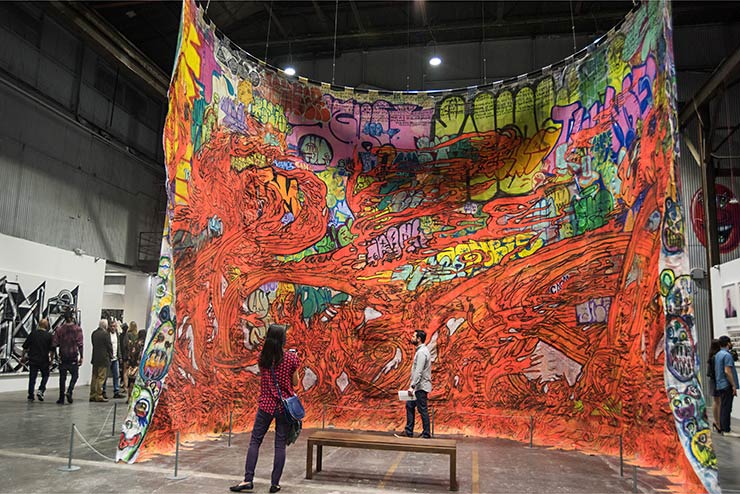
Takashi Murakami with Madsaki, Snipel, Tenga One and Onesker. Beyond The Streets. (photo © Martha Cooper)

Lady Pink. Beyond The Streets. (photo © Martha Cooper)

Charlie Ahearn . Futura . Lady Pink. Crash. Beyond The Streets. (photo © Martha Cooper)

Mr. Cartoon. Beyond The Streets. (photo © Martha Cooper)

Futura. Beyond The Streets. (photo © Martha Cooper)
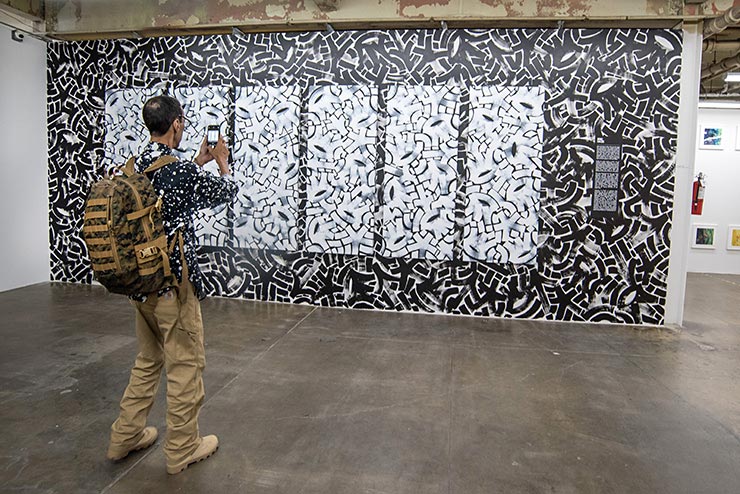
Futura takes a photo of Haze’s art work. Beyond The Streets. (photo © Martha Cooper)
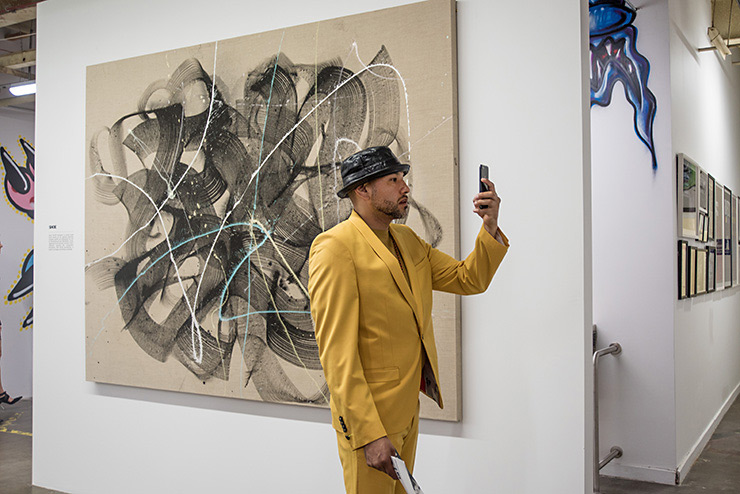
Niels Shoe Meulman. Beyond The Streets. (photo © Martha Cooper)

Ron Finley’s Gansta Gardener installation. Beyond The Streets. (photo © Martha Cooper)
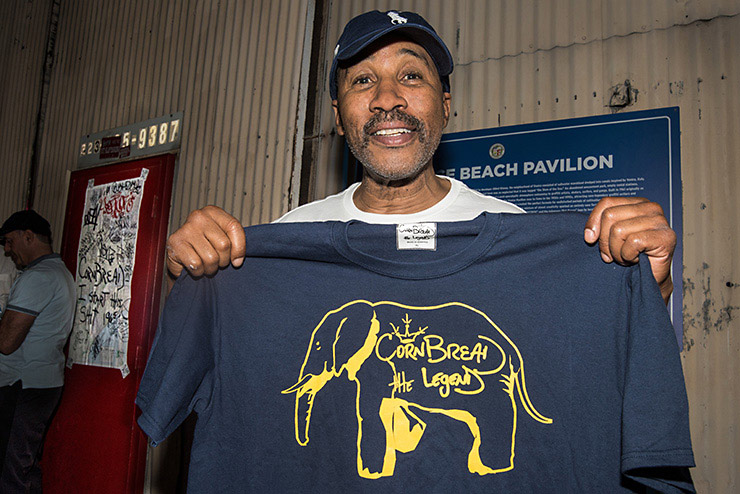
Corn Bread. Beyond The Streets. (photo © Martha Cooper)

Corn Bread. Beyond The Streets. (photo © Martha Cooper)
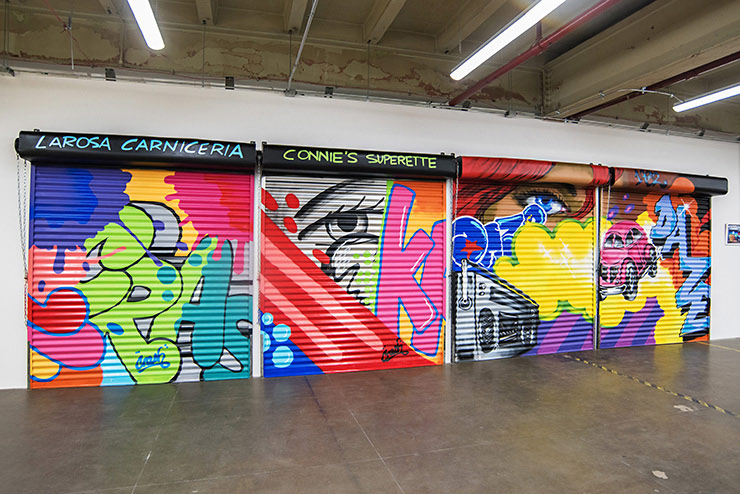
Crash . Daze. Beyond The Streets. (photo © Martha Cooper)

Katsu. Beyond The Streets. (photo © Martha Cooper)

Bill Barminski. Beyond The Streets. (photo © Martha Cooper)

Faith XLVII. Beyond The Streets. (photo © Martha Cooper)

Shepard Fairey. Beyond The Streets. (photo © Martha Cooper)

Jenny Holzer, Flashlight (In Collaboration With A-One). Beyond The Streets. (photo © Martha Cooper)

Blade. Beyond The Streets. (photo © Martha Cooper)

Aiko. Beyond The Streets. (photo © Martha Cooper)

Al Diaz. Beyond The Streets. (photo © Martha Cooper)

Barry Magee. Beyond The Streets. (photo and video below © Martha Cooper)

Beyond The Streets. (photo © Martha Cooper)
For more information please visit https://www.beyondthestreets.com/
Other Articles You May Like from BSA:
Our weekly focus on the moving image and art in the streets. And other oddities. Now screening : 1. Jorge Rodriguez-Gerada: Somos La Luz (We Are The Light)2. Vegan Flava: Migration In The Ant...
Every Street Art scene has what it calls its "Golden Age" - that time when artists are just popping up new pieces every week and you can sense a real evolution in style and substance is happening befo...
The patrimonial value given to ruins: the unusual, vaguely explained, and hardly registered constellation of architectural behemoths that are sprinkled through Sicily may be hardly prized, yet a ...
This week BSA is in Borås, a municipality in south-western Sweden for the 3rd edition of No Limit, a mural arts festival that brings Street Artists from around the world to create new works on walls...
A recent sunny day brought Baltimore Street Artist Toven outside to install some new work, including his humorous mashup of American romantic writer Edgar Allan Poe and an astronaut. An avid reader, t...
 BROOKLYN STREET ART LOVES YOU MORE EVERY DAY
BROOKLYN STREET ART LOVES YOU MORE EVERY DAY










